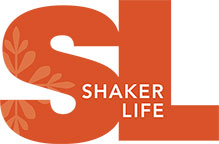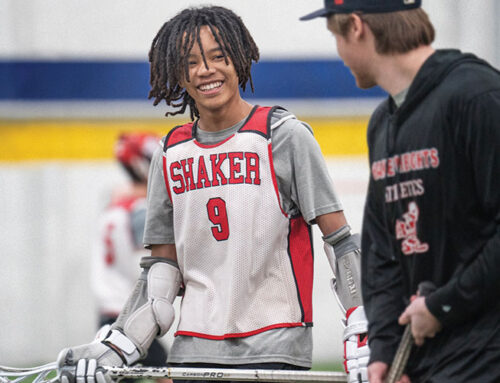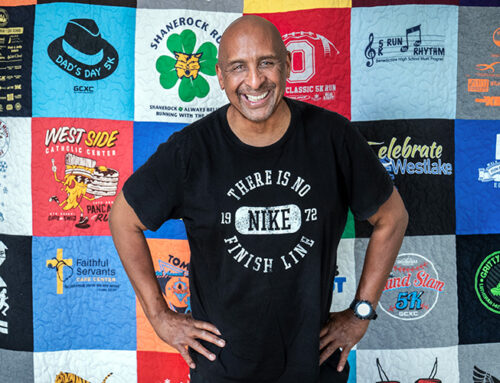The Mental Health Response Team, a pilot program that embeds a social worker with Shaker’s police and fire departments, is showing the way to better address the hundreds of mental health-related calls the City receives.
By Joe Miller

From left: Officer Martin Dunn, Police Chief Jeffrey DeMuth, Lt. Joseph Sepesy, Annette Amistadi, Fire Chief Patrick Sweeney, and Firefighters/Paramedics Olivia Ventura and Bobby Chalfant. Photos by Jason Miller.
Annette Amistadi may be a bit green when it comes to emergency response. But the veteran social worker knows what to do when she sees someone in a mental health crisis. When a 911 call took her to a Shaker Heights home in January, she says “the training kicked in.”
Police and paramedics were already on the scene “doing their best, 100 percent,” for a young woman having suicidal thoughts, Amistadi says. But fir0st responders aren’t mental health experts, and uniforms can be intimidating.
“She was sitting at the kitchen table crying,” says Amistadi. “I started talking to her and I was able to help with the de-escalation.” Soon she was helping the woman decide what to pack for a trip to the hospital. A week later Amistadi checked in to see how the woman was doing and to make sure she was keeping her appointments.
“That was a huge success, being able to see that she had what she needed,” says Amistadi, who will check in again. And if the woman needs to talk sooner, “she has my number.”
“We want to do the best for that resident,” says Fire Chief Patrick Sweeney. “We want to get them the care that they really need.”
Amistadi is a licensed independent social worker for Recovery Resources, part of the MetroHealth System. She is helping launch Shaker’s new Mental Health Response Team, a year-long pilot program that seeks to embed a mental health professional with Shaker’s police and fire departments 40 hours a week.
With a 2022 budget of $100,000 and MetroHealth as its partner, Shaker is hoping the pilot will show the way to better address the
hundreds of mental health-related calls the City receives each year.
Although MetroHealth was still looking for a full-time employee for the pilot at the time of publication, Amistadi, who directs case managers at Recovery Resources, will eventually oversee her successor in Shaker. Since January she has spent two days a week onsite, and has also led hour-long video calls with the City’s emergency responders three times a week.
Her accomplishments so far – Amistadi assisted 53 residents during the first three months of the pilot and regularly advises Shaker’s emergency personnel on other calls – have the City’s leaders already seeking to renew the program for 2023. And MetroHealth is hoping to use the pilot as a stepping stone for similar partnerships across Northeast Ohio.
“Annette has been the right person,” says Fire Chief Patrick Sweeney. “She has taken a strong lead on this and is starting to make an impact on the community.”

Officeres and firefighters/paramedics often seek out Amistadi’s insight and guidance.
“With Annette on the scene,” adds Shaker Police Chief Jeffrey DeMuth, “we now have someone who will follow up with those people. She is a tremendous resource to the police officers and firefighters.”
Like most communities across the country, Shaker has struggled to handle the impact of the nation’s growing mental health and addiction epidemics. The COVID-19 pandemic made matters worse. In 2019, before COVID-19, the Shaker Police Department estimates it received 470 emergency calls related to mental illness. While that’s a small percentage of the more than 37,000 calls that year, Sweeney and DeMuth believe those numbers are increasing.
Both chiefs remember responding to those types of calls early in their own Shaker careers during the late 1980s. Unfortunately, not much has changed over the years. For police offi cers, medics, and firefi ghters, often the best they can do is transport a mentally ill person in distress to a local emergency room.
“I’m hoping that this is something we can expand across Northeast Ohio,” says Dr. Julie Brunner, MetroHealth senior vice president of behavioral health and correctional medicine.
“We want to do the best for that resident,” says Sweeney. “We want to get them the care that they really need. The emergency room isn’t always the right place. I think we’re realizing there’s more of a need out there than we originally thought.”
Others were seeing the same issues. After events such as the murder of George Floyd sparked renewed scrutiny of police conduct, Shaker City Council members Tres Roeder and Anne Williams put together a task force to brainstorm how emergency responders could better help those with mental health problems.
“People close to me have been impacted by mental health,” says Roeder. “And I’ve heard many in the community share stories of how they have personally been impacted by mental health. Obviously, outcomes are better when proper treatment is received.”
The task force included DeMuth and Sweeney as well as community members like Roslyn English, a long-time Shaker resident who has struggled with her 35-year-old son’s schizophrenia for years. Mental illness in a loved one can be “a roller coaster,” English says.
But it has also pushed her to help “bring mental illness out of the shadows” by working with family support groups and advisory committees like the Shaker task force. And although she and her son have had good experiences with Shaker police, as the mother of a mentally ill Black man, English worries that might not always be the case for everyone.
“We wanted to maximize the potential for positive outcomes for my son and for other people dealing with mental health challenges,” English says. “It’s not necessarily the police who have to deal with this.”
The task force looked at the community’s needs and studied mental health programs around the country, from the modest to the ambitious, including a successful, multi-million-dollar crisis intervention system in Eugene, Oregon. In the end, task force members came up with a solution that they believed fit Shaker, and City Council unanimously approved $100,000 for the pilot. Shaker now needed to fi nd the right partner. MetroHealth jumped at the chance.
The Cuyahoga County hospital system had already been expanding its mental health and addiction services throughout the region, including a new $42-million behavioral health facility and psychiatric urgent care center opening in Cleveland Heights this fall.
“We’ve seen the impact of mental health and the complications and complexity of it when it occurs in the community and the community doesn’t have the right tools,” says Julia Bruner, MetroHealth senior vice president of behavioral health and correctional medicine. “We know that if the right interventions had been put in place prior to any of these events occurring, the outcome for that patient and that family would have been completely different. The needs are greater than they were just three years ago.”
Connecting Shaker with Recovery Resources is another step in that ongoing strategy, she says.
“I’m hoping that this is something we can expand across Northeast Ohio. Recovery Resources understands the needs of the community and the needs of the individual outside of clinical care,” Bruner says. “They understand housing and employment. They understand prevention. It’s the right fi t for them to be involved in this type of program.”
Amistadi, who has been at Recovery Resources since 2015, brings that group’s philosophy to the Shaker pilot and the residents she’s met. Some of them dial 911 several times in the same week. But the crises they are calling about often disguise the underlying issues, she says.
Amistadi builds rapport with people and then tries to fi nd them the right help, whether it’s a mental or physical health provider, an addiction treatment center, or even housing.
One woman was suffering from anxiety. After talking to her, Amistadi discovered the woman had a chronic health problem that involved numerous doctor appointments. Her anxiety was coming from trying to find and pay for transportation to those appointments. Amistadi, who uses resources from her main job as well as the occasional Google search, helped the woman consider her options and navigate her insurance.
“Mental health doesn’t live in a bubble. It’s all very much interconnected,” she says.
Some of Amistadi’s interactions with Shaker residents are in person – if it’s a 911 call, police or medics must be present – but more often it’s over the phone. Many are eager to talk to her; some turn her away. That doesn’t stop Amistadi.
“I have to find that window of when I can get in there and when they’re going to trust me.” she says. “It just takes a while. I guess it could never happen, but I’m at least going to try to make a difference.”
Once MetroHealth finds the right person to succeed her – a tight job market has made hiring slow – Amistadi will be ready to guide that social worker with a whole new breadth of knowledge.
“Over the past few months I’ve learned so much,” Amistadi says. “When I went to school there was no class on how to do this, or what it would look like, or how to work with EMS on the scene. As mental health professionals, we’re always looking at ways to do things differently and to do them better.”
While DeMuth and Sweeney sing Amistadi’s praises, both look forward to having a full-time mental health professional onsite. Already they’ve seen the benefits to officers and firefighters, who regularly pick Amistadi’s brain about the cases they’ve seen. But at the same time, they acknowledge that a social worker is only part of the solution.
Training is also part of it. Both chiefs have set goals to have all Shaker officers and firefighters take a 40-hour crisis intervention team training through the Alcohol, Drug Addiction and Mental Health Services Board of Cuyahoga County. Learning from experience is another part. Sweeney has hired an outside firm to create a database that tracks information on calls and follow-ups, allowing them to see who has needed assistance and what has worked – or not worked – in the past. DeMuth and Sweeney also hope for more opportunities with neighboring communities and partners, such as having social workers based at the regional 911 dispatch center to help determine the response needed. Or having mental health professionals available virtually around the clock for their rescue squads.
“We know that we can’t have a social worker physically in a police car or in an ambulance 24/7,” Sweeney says.
Still, the pilot is making an impact. English recently got to experience it first-hand. A week after Shaker police helped transfer her son to a hospital for the mentally ill, English received a check-in call from Amistadi.
“That was nice to know that the work we did on the committee has had an immediate impact and a team is in place,” English says.
Although she didn’t need Amistadi’s help this time, “it’s nice to know it’s there and she’s reaching out to people.”



